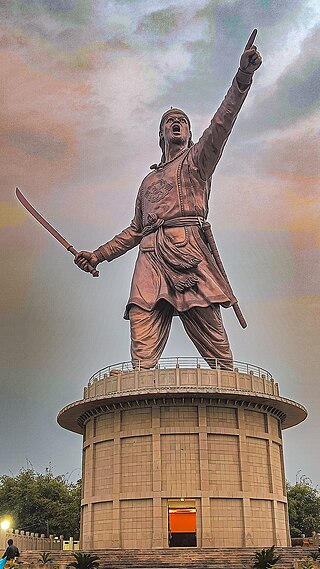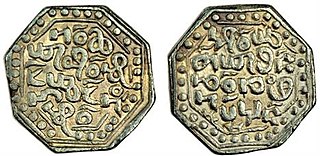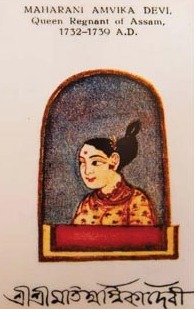
The Ahom dynasty (1228–1826) ruled the Ahom Kingdom in present-day Assam, India for nearly 598 years. The dynasty was established by Sukaphaa, a Shan prince of Mong Mao who came to Assam after crossing the Patkai mountains. The rule of this dynasty ended with the Burmese invasion of Assam and the subsequent annexation by the British East India Company following the Treaty of Yandabo in 1826.

Buranjis are a class of historical chronicles and manuscripts associated with the Ahom kingdom. There were written initially in the Ahom Language and later in the Assamese language as well. The Buranjis are an example of historical literature which is rare in India—they bear resemblance to Southeast Asian traditions of historical literature instead. The Buranjis are generally found in manuscript form, a number of these manuscripts have been compiled and published especially in the Assamese language.

Lachit Borphukan son of Momai Tamuli Borbarua was an Ahom Borphukan, primarily known for commanding the Ahom Army and the victory in the Battle of Saraighat (1671) that thwarted an invasion by the vastly superior Mughal Forces under the command of Ramsingh I. He died about a year later in April 1672.

The Moamoria rebellion (1769–1805) was an 18th-century uprising in Ahom kingdom of present-day Assam that began as power struggle between the Moamorias (Mataks), the adherents of the Mayamara Sattra, and the Ahom kings. This uprising spread widely to other sections of Ahom kingdom including disgruntled elements of the Ahom aristocracy leading to two periods in which the Ahom king lost control of the capital. Retaking the capital was accompanied by a massacre of subjects, leading to a steep depopulation of large tracts. The Ahom king failed to retake the entire kingdom; a portion in the north-east, Bengmara, became known as Matak Rajya ruled by a newly created office called Borsenapati, became a tribute-paying but virtually independent territory.

Suhungmung, or Dihingia Roja I was one of the most prominent Ahom Kings who ruled at the cusp of Assam's medieval history. His reign broke from the early Ahom rule and established a multi-ethnic polity in his kingdom. Under him the Ahom Kingdom expanded greatly for the first time since Sukaphaa, at the cost of the Chutia and the Dimasa kingdoms. He also successfully defended his kingdom against Muslim invasions, first by a general called Bar Ujjir and another by Turbak Khan. During his time, the Khen dynasty collapsed and the Koch dynasty ascended in the Kamata kingdom. His general, Ton-kham, pursued the Muslims up to the Karatoya river, the western boundary of the erstwhile Kamarupa Kingdom, the farthest west an Ahom military force had ventured in its entire six hundred years of rule.

The Ahom kingdom was a late medieval kingdom in the Brahmaputra Valley that retained its independence for nearly 600 years despite encountering Mughal expansion in Northeast India. Established by Sukaphaa, a Tai prince from Mong Mao, it began as a mong in the upper reaches of the Brahmaputra based on wet rice agriculture. It expanded suddenly under Suhungmung in the 16th century and became multi-ethnic in character, casting a profound effect on the political and social life of the entire Brahmaputra valley. The kingdom became weaker with the rise of the Moamoria rebellion, and subsequently fell to repeated Burmese invasions of Assam. With the defeat of the Burmese after the First Anglo-Burmese War and the Treaty of Yandabo in 1826, control of the kingdom passed into East India Company hands.

Barua is a common Assamese surname. This term is different and not to be confused with the surname used by Buddhists from Bangladesh, Myanmar and Tripura, who also use Barua as surname. Baruah can also belong to converted Brahmin Caste. Baruah in Assam generally belongs to Brahmin Caste. Surnames include Baruah, Barooah, Barua.
Choapha Supatpha also Swargadeo Gadadhar Singha, was the twenty-ninth king of Ahom kingdom, who reigned from 1681 to 1696. He established the rule of Tungkhungia royal house of Ahom kings, whose descendants continued to rule till the climactic end of the Ahom kingdom in 1826. He was earlier known as Gadapani Konwar and was a son of Gobar raja, a descendant of Suhungmung, and who had become king for twenty days. Gadadhar Singha stabilized the Ahom kingdom, which was going through a long decade of political turmoil and instability. This period saw the ruthless power grab of Debera Borbarua and Laluksola Borphukan's abandonment of Guwahati to the hands of Mughals and oppression via Sulikphaa alias Lora Roja.

Sukhrungphaa or Swargadeo Rudra Singha was the 30th Ahom king, reigning from 1696 to 1714 A.D. His father Gadadhar Singha freed Assam from the Mughal disturbances and internal conspiracies, thereby Rudra Singha inherited a stable state and government and had the advantage of the solid foundations laid by his father. He devoted his time to transform Assam into a first-rate power in India. He stopped the persecution of the Neo-Vaisnava sect and built temples, several public works, and patronized art, literature, and culture. Rudra Singha is also famed for being the real father of Ahom architecture. He giving up the isolationist policy of his predecessors forged diplomatic ties with various states of that time and established extensive trade with Bengal.

Shiva dol is a group of structures comprising three Hindu temples of Sivadol, Vishnudol and Devidol shrines, and a museum. These are located on the banks of the Sivasagar tank, also known as the Borpukhuri tank, in the heart of Sivasagar, in the Indian state of Assam. The tank was constructed between 1731 and 1738 and the temples were built in 1734 by Bar Raja Ambika, queen of Ahom king Swargadeo Siva Singha (1714–1744). The height of the Sivadol is 104 feet (32 m) and the perimeter is 195 feet (59 m) at the base. It is crowned with an 8-foot (2.4 m) high golden-dome.

Sunenphaa also, Pramatta Singha, was the king of Ahom Kingdom. He succeeded his elder brother Swargadeo Siva Singha, as the king of Ahom Kingdom. His reign of seven years was peaceful and prosperous. He constructed numerous buildings and temples. The most famous of his buildings was the Rang Ghar, which is also considered as the oldest amphitheatre in Asia.

Sutanphaa also Siva Singha was the 31st king of Assam from the Ahom dynasty who reigned from He was the eldest son of King Rudra Singha. Siva Singha was with his dying father at Guwahati, who then proceeded to the capital Rangpur where he ascended to the throne. He is noted for his elaborate system of espionage. He had numerous temples erected and made large gifts of land to them. With his patronage, Hinduism became the pre-dominant religion of the Ahoms. The king was also a patron of music and literature and music and himself composed Sanskrit songs and learnt songs. His reign coincided with the arrival of the first Europeans traders into Assam.

Suklingphaa, or Kamaleswar Singha, was a king of the Ahom kingdom. He came to power when he was a toddler, and died in his teens during a small pox epidemic. The de facto ruler during his reign was Purnanada Burhagohain, who was able to consolidate power after installing him on the throne; and his parents Kadamdighala and Numali also were very powerful. Kamaleswar Singha's reign witnessed the suppression of Moamoria rebellion and restoration of Ahom rule over Upper Assam. The Dundiya Revolution in Kamrup was also suppressed during his reign. In Nagaon, the Ahom army also managed to defeat a coalition of Moamoria rebels and the Kacharis of Kachari Kingdom. Much of this was the handiwork of Purnananda Burhagohain and not Kamaleshwar Singha.

Sudingphaa also, Chandrakanta Singha, was a Tungkhungia king of the Ahom dynasty, who ruled at the climactic of the Ahom kingdom. His reign witnessed the invasion of Burmese on Assam and its subsequent occupation by British East India Company. He was installed as King twice. His first reign ended when Ruchinath Burhagohain deposed him and installed Purandar Singha in his stead. His second reign ended with his defeat at the hands of the invading Burmese army. He continued his militant efforts to regain his kingdom as well as to keep Purandar Singha at bay. Finally he submitted himself to Burmese who induced him to believe that they will make him king. Instead he was seized and placed in confinement at Rangpur. After the defeat of Burmese in the First Anglo-Burmese War and subsequent peace Treaty of Yandabo on 24 February 1826 CE, Assam passed into the hand of British. Most of the members of Ahom Royal family were granted pensions. Chandrakanta Singha received a pension of 500 rupees. He first lived in Kaliabor and later on at Guwahati. He visited Calcutta in order to request the restoration of his kingdom but in vain. He died in 1839 CE soon after his return to Guwahati.

Jogeswar Singha was installed as the king of Ahom kingdom in 1821 CE, by the Burmese. He was more or less a puppet in the hands of the Burmese, who held the real power of administration. His reign witnessed Burmese atrocities on the people of Assam and the attempts made by Chandrakanta Singha and Purandar Singha to expel Burmese invaders. Historians dispute regarding the date of his deposition from the throne, as some historians claimed that he was deposed by his Burmese masters, after they secured complete victory over the forces of Chandrakanta Singha in 1822 CE, while some sources claimed that he remained as a puppet ruler till termination of Burmese rule in Assam by British East India Company, in 1825 CE, during First Anglo-Burmese War.

Sunyatphaa also Udayaditya Singha was the king of Ahom Kingdom from 1670 CE to 1672 CE. After his elder brother Swargadeo Chakradhwaj Singha died in the middle of Ahom-Mughal war, Udayaditya Singha succeeded to the throne. His reign witnessed the end of Ahom-Mughal war, which started during the reign of Chakradhwaj Singha, when the Mughal army led by Rajput prince, Ram Singh I of Amber, was decisively defeated by the Ahom forces led by Ahom commander Lachit Borphukan in the Battle of Saraighat. The later part of his reign was characterized by the failure of military expedition against the Dafala tribes and the influence of Paramananda Sannyasi, a saintly figure from Brindaban, over Udayaditya Singha. Udayaditya's over exerted devotion towards Paramananda Sanyasi, aroused dissatisfaction among the nobles, which ultimately caused his deposition and execution. His reign was followed by a series of political anarchy and internal disturbances in the Ahom kingdom which continued till the accession of Gadadhar Singha in 1681 CE.
Rai Bahadur Surya Kumar Bhuyan MBE (1892–1964) was a writer, historian, educator, social activist, storyteller, essayist, professor and a poet from Assam. He has written many books on ancient history, stories, essays, biographies, etc. in the world of Assamese literature. He presided over the Asam Sahitya Sabha (1953) held at Shillong. He was the elected member of Rajya Sabha during 1952–53, and was awarded the Padma Shri by the Government of India in 1956.

Battle of Samdhara was the first naval battle fought between Mughals and the Ahoms in 1616

Ambika, Bar Raja was the Chief Consort of Ahom King, Sutanphaa. She became Bar Raja, shortly after the death of her older sister, Phuleshwari. She is known for constructing the Sivasagar Sivadol and the Sivasagar Tank. She was a great patron of learning and education.

Sri Sri Auniati Satra is a satra or monastery located in the Majuli river island in Assam, India, that adheres to the Brahma Sanghati of the Ekasarana Dharma, a socio-religious and cultural movement initiated by Srimanta Sankaradeva, who was born in 1449 CE. It is one of the four "raj satras" or royal satras associated with the Ahom dynasty. It is the first satra patronised by the kingdom. It is usually believed that this satra was established in the year 1653 CE, with the initiative of Ahom king Jayadhwaj Singha, the first head monk or satradhikar being Sri Sri Niranjana Deva Goswami, even though different opinions exist.













